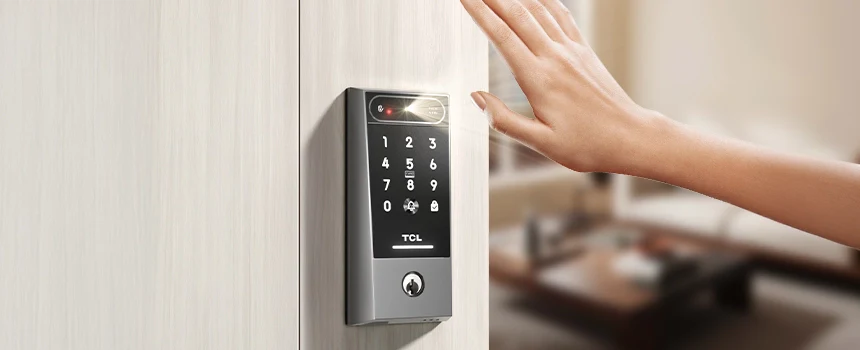
Smart Homes 2025: Why Palm Vein Authentication is Replacing Traditional Locks
|
|
Tiempo de lectura 4 min
|
|
Tiempo de lectura 4 min
Table of Content
As technology for smart homes evolves, traditional locks are getting obsolete. By 2025, the palm vein is set to become the top security option for homes of the future. Contrary to codes, keys, as well as fingerprint scanners, palm vein recognition gives the highest level of security, comfort and a futuristic look.
For long periods of time, mechanical locks and keys were the norm in security at home. However, they do have major disadvantages.
Keys that are stolen or lost are A significant security hazard that needs to be addressed by a lock replacement.
Lock picking and bumping Locks that are traditional locks are susceptible to burglaries.
Remote access is not available. Keys aren't compatible with smart home systems.
However, smart locks that use fingerprint scanners or PIN codes aren't without flaws:
Fingerprints are able to be copied by using high-resolution images as well as silicone moulds.
Codes are hackable or surfing shoulder-surfed.
Battery dependence: A lot of smart locks fail when power is not available.
Palm vein authentication addresses these issues with Biometric Security that's virtually impossible to duplicate.
The palm vein detection is a biometric technology that is not a contact which scans the distinct vein patterns within a human hand. This is how it works:
The Infrared Scanning Near-infrared light can detect vein patterns underneath the skin.
The blood flow is imaged by taking advantage of the fact that hemoglobin in human venous blood is sensitive to infrared light of a specific wavelength.
The imaging is transformed and feature extracted through professional algorithms to extract specific features that can maximize the distinction between different veins, and identity recognition is performed using the transformed and extracted features.
Instant Verification: The system compares the data stored in the scan to verify the identity of the user.
Why Vein Patterns Are More Secure Than Fingerprints
Impossible to duplicate – Veins are internal, unlike fingerprints left on surfaces.
Liveness detection – Only works with real, blood-flowing hands (prevents spoofing).
No physical contact – More hygienic than fingerprint scanners.
1. Unbeatable Security
The vein patterns on the palm are distinctive to each individual--even identical twins have distinct vein structure. In contrast to fingerprint cloning, vein reproduction is virtually impossible, which makes it perfect for homes that require high security.
2. Contactless & Hygienic
In the post-pandemic era, contactless access is a must. Palm vein scanners don't require physical contact, thus limiting the risk of spreading germs as compared with keys or fingerprint locks.
3. Seamless Smart Home Integration
The latest palm vein lock is connected directly to home automation devices such as:
Voice Assistants (Alexa, Google Home, Siri)
Smart lighting & HVAC control
Security cameras and alarms
Imagine the door opening immediately after your palm is scan before adjusting the lights and temperature according to your preference.
4. No More Keys or Passwords
Do not carry keys around or keep track of codes. Palm vein authentication offers access to your home without passwords--just tap your palm to unlock the door.
5. Future-Proof Technology
In the future, as AI as well as biometrics develop, the Palm vein systems could allow:
Multi-factor authentication (vein + facial recognition)
Security based on blockchain for access control that is decentralized
Learning adaptively increases the accuracy of your web browser over time.
| Feature | Palm Vein | Fingerprint | PIN Code | Traditional Key |
| Security | ★★★★★ | ★★★☆ | ★★☆ | ★★☆ |
| Convenience | ★★★★★ | ★★★★☆ | ★★★☆ | ★★☆ |
| Hygiene | ★★★★★ | ★★★☆ | ★★★☆ | ★★★★☆ |
| Spoof-Proof | ★★★★★ | ★★☆ | ★☆ | ★☆ |
| Smart Home Integration | ★★★★★ | ★★★★☆ | ★★★☆ | ☆ |
Leading smart lock manufacturers (like Samsung, Yale as well and August) have incorporated the palm vein technology into their newest models. Here's the way homeowners are using it:
Keyless entry: No more searching for keys during the night.
Temporary Access Access granted via veins to service or guest workers.
Children & Elderly Safety - Kids don't lose keys, and seniors won't have to keep track of codes.
Security High Areas: Secure the safes of home office spaces and private spaces.
While palm vein tech is revolutionary, some factors remain:
Higher initial cost – More expensive than basic smart locks (but prices are dropping).
Power requirements – Needs electricity (though backup batteries are common).
Learning curve – Some users may prefer traditional methods initially.
However, as adoption grows, these barriers will diminish.
By 2030, palm vein tech could expand beyond door locks to:
Car ignitions – Replace key fobs with biometric starts.
Payment systems – Secure, touchless transactions.
Healthcare access – Hospitals using vein scans for patient records.
By 2025, the palm vein authentication will set standards for safe, keyless and future-proof access to your home. With the highest security hygiene, as well as smart home integration, there's no reason to be surprised that locks of the past are getting obsolete.
For those who are looking to purchase new-generation security, the palm vein system provides the ideal blend of technology and security. As biometrics improve in the near future, we may be living in a world where keys are gone forever.
Explore the latest palm vein recognition smart locks and step into the future of home automation today!
